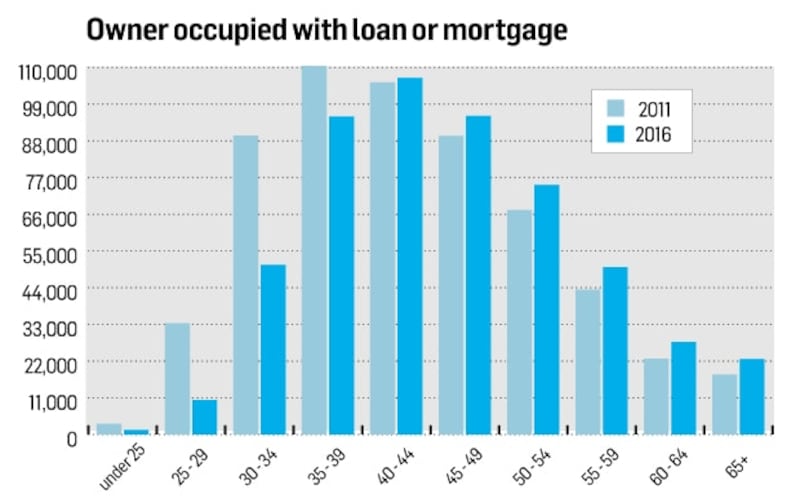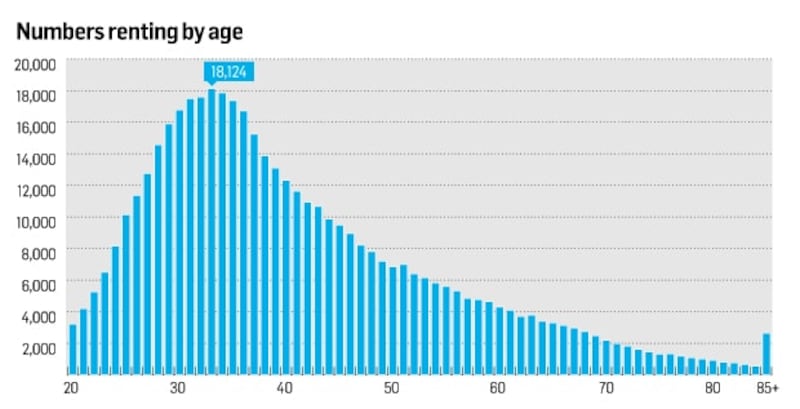The staggering scale of Ireland's housing crisis has been laid bare by the Central Statistics Office, with figures from the 2016 census showing that the total stock grew by a tiny fraction – only 0.4 per cent – over the previous five years, despite a huge increase in demand for accommodation.
In what the CSO described as a “clear picture” of some of the main developments in housing since 2011, only 8,800 units were added to the stock in that period, in sharp contrast to the growth of 225,232 dwellings recorded between 2006 and 2011, towards the end of the property bubble era.
The report provides a harsh reality check on exaggerated claims made about the output of new housing
The publication of Housing in Ireland, the first of several "thematic profiles" from the 2016 census, underlines the daunting challenge facing the Minister for Housing, Simon Coveney, and provides a harsh reality check on exaggerated claims made about the output of new housing.
The Minister himself conceded on RTÉ Radio’s News at One on Thursday that the CSO figures presented a “stark story” about the “fundamental structural problem in the housing sector”.
And while it was his job to “fix it”, Mr Coveney acknowledged that “the problem cannot be solved overnight”. Indeed not.
However, in defining his job as “to make sure we have an industry that can build enough houses so we are not reliant on the private rental sector”, the Minister evoked his ideological commitment to home ownership as a goal, instead of taking a much broader view of housing provision.

The truth is that the number of owner-occupied homes fell between 2011 and 2016 (from 1,149,924 to 1,147,552) causing the overall rate to drop from 69.7 per cent to 67.6 per cent, a level last seen in 1971.
In urban areas, it fell even lower, from 61.6 per cent to 59.2 per cent in 2016.

Big rent increases
Renting is now more common than owning for younger people, at least until the age of 35 (in 1991 the equivalent age was 26).
But the relative shortage of private rental accommodation has resulted in big rent increases over the past five years, with the highest growth (almost 30 per cent) in Dublin city.

As homeless charity Focus Ireland noted, the CSO report showed that the number of renters paying at least €300 per week to private landlords has shot up 166 per cent to 48,933. (The average weekly rent throughout the State in April 2016 was €199.92, up from €171.19 in 2011.)
And while the number of vacant homes fell by 15 per cent between 2011 and 2016, there are still more than 183,000, even after excluding holiday homes.
For the first time, this has been broken down to nearly 80,000 detached houses, 60,000 semi-detached or terraced houses, and nearly 43,000 apartments.
The highest levels of vacancy are in rural areas, but there are still a large number of vacant homes in urban areas
Not surprisingly, the highest levels of vacancy are in rural areas, but there are still a large number of vacant homes in urban areas, including Dublin.
If targeted measures were taken to bring these back into use, even for rental, the current housing emergency would be substantially alleviated.
But this would require legislation to “vest” vacant properties in local authorities, and there is no willingness to do that – due to the long-standing fear of interfering with the constitutional right to private property, which is what stymied implementation of the 1974 Kenny Report on Building Land.
New homes obsession
As a result, the primary focus of Rebuilding Ireland – the Government’s housing programme – is on the production of new homes for sale, rather than rental.
This will only happen, however, when prices rise even further to make it more profitable for house builders to get back into business.
That's what lay behind the help-to-buy scheme introduced in the last Budget, for which the Construction Industry Federation had lobbied intensively, even though independent economists and others had warned that it would simply be absorbed by higher house prices, which is precisely what happened.
“I make no apologies for helping first-time buyers get a leg up,” the Minister told RTÉ.
Responding to Fianna Fáil housing spokesman Barry Cowen’s call for an independent review of the incentive, Mr Coveney insisted that it would stay in place as it had “only just started”. Yet such a review is clearly needed.
As Mr Cowen noted, residential property prices rose 10.7 per cent in the year to February – “the fastest rate of growth since May 2015” – and showed that the rate of property price inflation price was accelerating.
The Minister needs to recognise that many people simply cannot afford to purchase property at inflated prices
Any notion that the widespread production of new homes would make them more affordable for first-time buyers (or, indeed, anyone) is utterly misplaced: Let us not forget the fact that record levels of house-building went hand-in-hand with soaring house prices during the bubble period.
Instead of focusing on first-time buyers, the Minister needs to recognise and accept that many people simply cannot afford to purchase property at inflated prices; they need to be catered for through the provision of social and affordable housing, built by local authorities or dedicated housing associations.
Not too long ago, Mr Coveney’s department was dealing with the phenomenon of ghost estates scattered around the country.
Unfortunately, that single-minded focus led to policymakers missing the underlying trend of an ever-growing demand for housing in places where people want to live.











